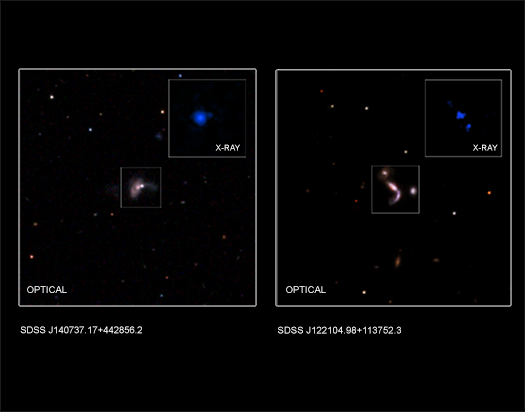Last week, we learned that the 2017 Nobel prize for physics went to Rainer Weiss, Barry Barish and Kip Thorne for their fundamental contributions to the LIGO detector and its ground-breaking observation of elusive gravitational waves. Scientists at LIGO, and, subsequently, those using the Virgo interferometer have now detected gravitational waves – ripples in the fabric of spacetime – from relatively small merging black holes, between about eight and 36 times the mass of the sun. Meanwhile, also last week, astronomers announced a bumper crop of merging supermassive black holes – each containing millions of times the mass of the sun – in the centers of galaxies. A statement from Chandra X-ray Observatory said:
This discovery could help astronomers better understand how giant black holes grow and how they may produce the strongest gravitational wave signals in the universe.
It’s believed these black hole couples formed when two galaxies collided and merged with each other, forcing their supermassive black holes close together.
Models predict dual supermassive black holes, but fewer than 10 confirmed pairs of growing black holes were known from X-ray studies, and they were found mostly by chance. To carry out a systematic search, the team had to sift through data from telescopes that detect different wavelengths of light.
Shobita Satyapal, from George Mason University in Fairfax, Virginia, led one of two papers describing these results. Her team reported on four of the dual black hole candidates in a paper that’s been accepted for publication in the peer-reviewed Astrophysical Journal. She commented:
Astronomers find single supermassive black holes all over the universe. But even though we’ve predicted they grow rapidly when they are interacting, growing dual supermassive black holes have been difficult to find.
To find the supermassive black hole pairs, astronomers started with optical data from the Sloan Digital Sky Survey (SDSS), searching for small galaxies that appeared to be merging. They especially focused on objects where the separation between the centers of the two galaxies in the SDSS data appeared to be exceedingly small, less than 30,000 light years.
They then turned to data from the Wide-field Infrared Survey Explorer (WISE). They looked for a match between the Sloan data and the WISE data showing what had been predicted to be seen in the infrared, for a rapidly growing supermassive black hole. In this way, they found seven systems that appeared to contain at least one supermassive black hole.
At that point, they turned to the X-ray data. Their statement explained:
Because strong X-ray emission is a hallmark of growing supermassive black holes, Satyapal and her colleagues then observed these systems with [the Chandra X-ray Observatory]. Closely-separated pairs of X-ray sources were found in five systems, providing compelling evidence that they contain two growing (or feeding) supermassive black holes.

Sara Ellison of the University of Victoria in Canada, led the other paper describing these results. Her team’s report on the 5th black hole candidate was reported in the September 2017 issue of the peer-reviewed Monthly Notices of the Royal Astronomical Society. Ellison said:
Our work shows that combining the infrared selection with X-ray follow-up is a very effective way to find these black hole pairs. X-rays and infrared radiation are able to penetrate the obscuring clouds of gas and dust surrounding these black hole pairs, and Chandra’s sharp vision is needed to separate them.
Could the LIGO or Virgo instrumentation be pointed toward these newly discovered giant black hole pairs, in order to detect gravitational waves from them? Apparently the answer is no. They’re just not set up to detect this particular type of gravitational wave. Instead, pulsar timing arrays such as the North American Nanohertz Observatory for Gravitational Waves (NANOGrav) are currently performing this search. And, in the future, the astronomers said, the Laser Interferometer Space Antenna (LISA) project could also search for these gravitational waves.
Read more: How gravitational waves attracted a Nobel Prize

Bottom line: Scientists have announced 5 new pairs of merging supermassive black holes, in the centers of distant galaxies.











